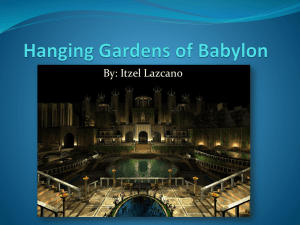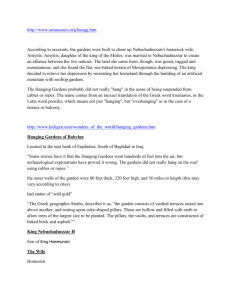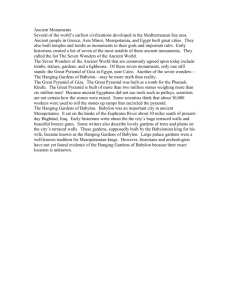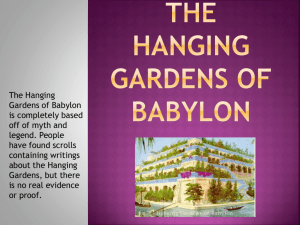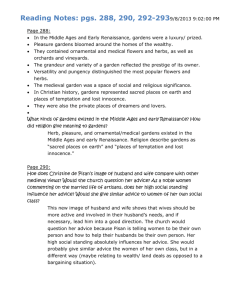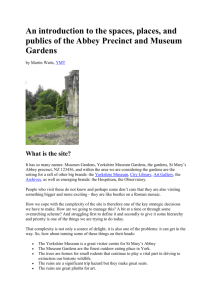The Hanging Gardens of Babylon
advertisement
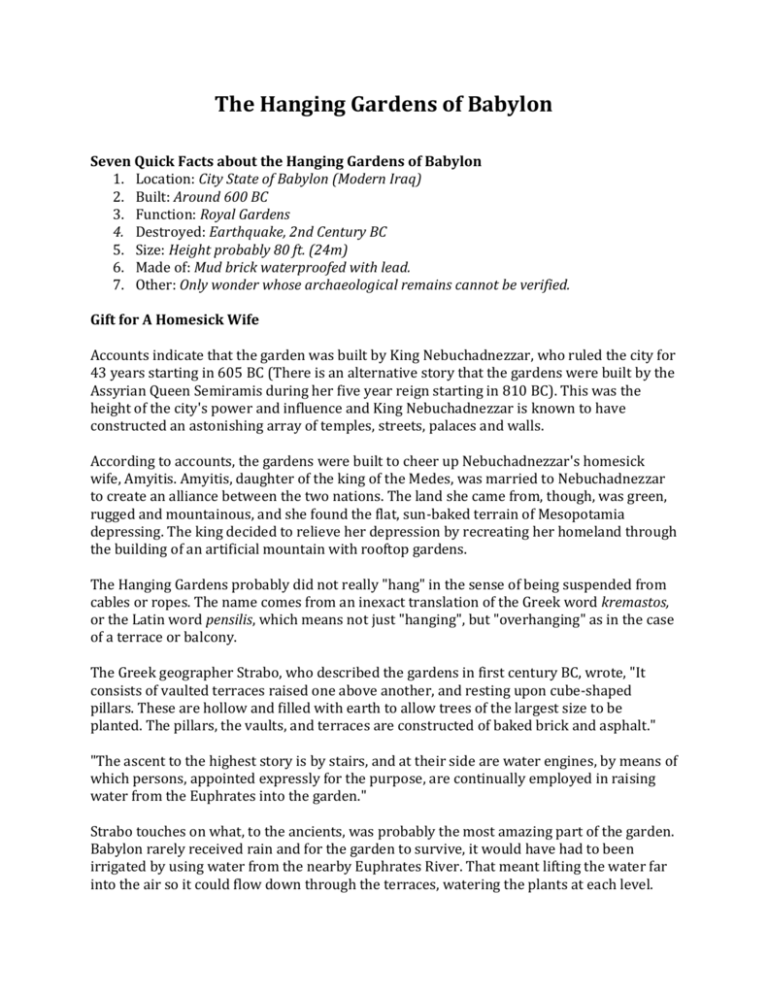
The Hanging Gardens of Babylon Seven Quick Facts about the Hanging Gardens of Babylon 1. Location: City State of Babylon (Modern Iraq) 2. Built: Around 600 BC 3. Function: Royal Gardens 4. Destroyed: Earthquake, 2nd Century BC 5. Size: Height probably 80 ft. (24m) 6. Made of: Mud brick waterproofed with lead. 7. Other: Only wonder whose archaeological remains cannot be verified. Gift for A Homesick Wife Accounts indicate that the garden was built by King Nebuchadnezzar, who ruled the city for 43 years starting in 605 BC (There is an alternative story that the gardens were built by the Assyrian Queen Semiramis during her five year reign starting in 810 BC). This was the height of the city's power and influence and King Nebuchadnezzar is known to have constructed an astonishing array of temples, streets, palaces and walls. According to accounts, the gardens were built to cheer up Nebuchadnezzar's homesick wife, Amyitis. Amyitis, daughter of the king of the Medes, was married to Nebuchadnezzar to create an alliance between the two nations. The land she came from, though, was green, rugged and mountainous, and she found the flat, sun-baked terrain of Mesopotamia depressing. The king decided to relieve her depression by recreating her homeland through the building of an artificial mountain with rooftop gardens. The Hanging Gardens probably did not really "hang" in the sense of being suspended from cables or ropes. The name comes from an inexact translation of the Greek word kremastos, or the Latin word pensilis, which means not just "hanging", but "overhanging" as in the case of a terrace or balcony. The Greek geographer Strabo, who described the gardens in first century BC, wrote, "It consists of vaulted terraces raised one above another, and resting upon cube-shaped pillars. These are hollow and filled with earth to allow trees of the largest size to be planted. The pillars, the vaults, and terraces are constructed of baked brick and asphalt." "The ascent to the highest story is by stairs, and at their side are water engines, by means of which persons, appointed expressly for the purpose, are continually employed in raising water from the Euphrates into the garden." Strabo touches on what, to the ancients, was probably the most amazing part of the garden. Babylon rarely received rain and for the garden to survive, it would have had to been irrigated by using water from the nearby Euphrates River. That meant lifting the water far into the air so it could flow down through the terraces, watering the plants at each level. This was an immense task given the lack of modern engines and pressure pumps in the fifth century B.C.. Controversy Some historians argue that the gardens were only a fictional creation because they do not appear in a list of Babylonian monuments composed during the period. Either that or they were mixed up with another set of gardens built by King Sennacherib in the city of Nineveh around 700 B.C.. Is it possible that Greek scholars who wrote the accounts about the Babylon site several centuries later confused these two different locations? If the gardens really were in Babylon, can the remains be found to prove their existence? If they did exist, what happened to the gardens? There is a report that they were destroyed by an earthquake in the second century B.C.. If so, the jumbled remains, mostly made of mud-brick, probably slowly eroded away with the infrequent rains. Whatever the fate of the gardens were, we can only wonder if Queen Amyitis was happy with her fantastic present, or if she continued to pine for the green mountains of her distant homeland.
